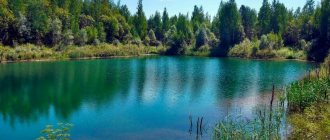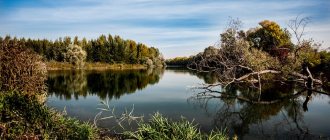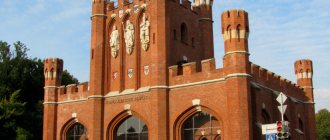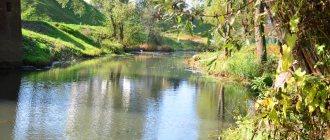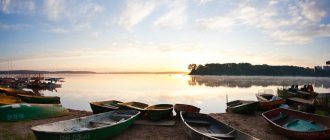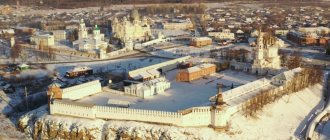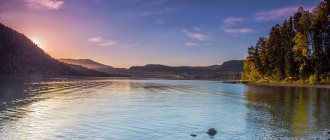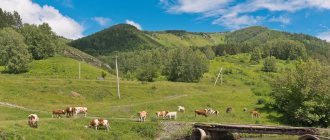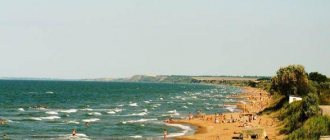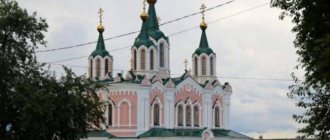Pervomaisky Park
Located in the Central District, at the address: st. Uritsky, 5.
Located at a distance:
- 25.2 m – from the building of the Administration of the Kursk Region;
- 115 m – from the Znamensky Cathedral;
- 142 m – from the Museum of Local Lore.
It borders on Red Square, Uritsky and Sonin streets.
It occupies an area of 14 hectares. Landscaped green space. Located on a hill. From st. Uritsky to st. Sonina passes through the central alley, dividing the territory in half. On the outskirts of the park there are attractions for children and adults.
In the eastern part there is a Ferris wheel; it offers views of the Tuskar River and Streletskaya Sloboda. Along the alleys there are benches, gazebos and lanterns. At the entrance to the park from Red Square. A monument to Alexander Nevsky was erected on a high cylindrical pedestal with the inscription: “God is not in power, but in truth.” From it there is a path with flower beds.
Zones highlighted:
- recreation (with gazebos, benches);
- entertainment (with rides, playground, trampolines, slides);
- sanitary zone.
54.9 m from the monument to A. Nevsky, a bust of Hero of the Soviet Union A. E. Borovs was installed. There is a cafe.
Religious buildings
There are several religious buildings located within the central part of the city. The main one is the Znamensky Cathedral , the construction of which was timed to coincide with the victory in the War of 1812. It received its name in honor of the “Sign” icon, brought here from the Root Hermitage on the opening day. The cathedral is located in the very center of Kursk on the territory of the Znamensky Monastery.
Photo: © Igor Butyrskii
Next to the cathedral is the brick single-domed Church of the Resurrection of Christ , built in 1875 with donations from townspeople. In the 1920s, it was closed for worship until the early 2000s. Currently under restoration.
If you walk from Red Square up Lenin Street (and parallel to Maxim Gorky Street), you can see several more churches - Resurrection-Ilyinsky Church , Holy Trinity Church , Sergius-Kazan Cathedral .
A notable religious building is the Church of the Assumption of the Virgin Mary . It was built in 1892-1896. in neo-Gothic style. It is curious that it was here that the artist Kazimir Malevich, who lived in Kursk for about 10 years, got married and baptized his children. The house where he lived has been preserved in the city - the House of A.F. Bezhodarny at 17 Pochtovaya Street. Residents and guests of the city can visit the church and listen to an organ concert.
Photo: © acvazul-v2010
If you have time, it’s worth getting to the Temple of the Holy Royal Passion-Bearers . This is a relatively young five-domed temple, built in 2008-2010. using motifs from Vladimir ancient church architecture. The temple is operational, and believers can attend services.
Not far from Dobrolyubov Square rises the majestic Church of the Life-Giving Trinity .
The holy place of pilgrimage is the Korennaya Pustyn Monastery on the banks of the Tuskar River, 33 km from the center of Kursk. It was founded in the 13th century on the site of the miraculous discovery in 1295 of the icon of the Sign of the Blessed Virgin Mary on the root of a tree. Currently, the original icon is located in the Znamensky Cathedral of the Russian Orthodox Church in New York.
Among the shrines of the monastery are a large reliquary with the relics of the venerable Kiev-Pechersk and Optina elders and two relics with the relics of saints, saints, righteous people and martyrs.
Photo: © acvazul-v2010
Ermoshkino Lake
Located in the Seimsky district, at the address: st. Gagarina, 23.
Located at a distance:
- 65 m – from residential buildings;
- 282 m – from the Polytechnic College;
- 351 m - from the Patriot sports club.
At 743 m there is a busy highway - Kulakova Ave.
Recreational space in a residential neighborhood. In the center there is an artificial reservoir (pit) with an uneven bottom, with sharp depressions. The size of the water surface is almost 60,000 m2; the depth reaches 8 - 10 m. Trees grow around the lake. Pedestrian paths in the coastal area are paved. Lanterns and benches are installed along them.
There is a recreation area with a sandy beach around the lake. There is a rescue station. A volleyball court and a small sports ground with horizontal bars have been created on the banks. There is a cafe 27 m from the lake.
Top 10 most beautiful places
The nature of the Kursk region is picturesque and unique. The banks of reservoirs serve as resting places. Steppes and forests form a beautiful landscape that attracts the eye.
Lake Fitizh
Located in the Lgovsky district, it ranks 3rd in size among other reservoirs in the region. It is distinguished by large reserves of fish. Recreation centers and tent camps are located on the banks. Strawberries and mushrooms grow in the forest around the lake. This place is attractive to tourists and local residents who collect the gifts of nature here.
There is good fishing on Lake Fitizh.
Psel River
The Psel River is a major waterway in the region. The constructed hydroelectric power station provides the region with electricity, and water is used to irrigate fields.
The river is a wonderful place to relax.
Here you can admire swimming wild ducks, waders, and fish. In the adjacent forest you can see hares, wild boars, foxes, and beavers.
There are a lot of fish in the Psel River.
Kursk Sea
The Kurchatov Reservoir (Kursk Sea) is more than 40 years old. It is intended to supply water to residents of the region. Its shores are so picturesque that they attract many vacationers in the summer, especially on weekends. A comfortable area for tourists has been created here, and a beach has been equipped.
The Kursk Sea is a favorite recreation area for city residents.
Besedinskoye settlement
The ancient city on the banks of the river was built in the 4th century. BC. In the 12th century. it was destroyed by the Tatar-Mongol invaders. Archaeologists discovered ancient treasures with jewelry on the territory.
There was an ancient city in the Besedin settlement.
Gochevskoye settlement
It is believed that in ancient times there was a city of Rimov in this place. The settlement is located in the Belovsky district on the banks of the Psel River. During the excavations, archaeologists discovered blacksmithing equipment, jewelry, and military weapons.
Gochevskoye settlement near the banks of the river.
Streletskaya steppe
Has the status of a nature reserve. In 1626, the territory was given by the Tsar to the Streltsy. The steppe has never been plowed. It was used for grazing livestock and making hay, so many species of wild plants were preserved on the territory. Every month from the beginning of spring to late autumn, the steppe changes color, surprising with its beauty.
You will also like: The most beautiful and interesting places in Torzhok
Streletskaya steppe with rare herbs.
Karyzhsky forest
Created by foresters in the 19th century. on the banks of the Seim River. On an area of about 2000 hectares, not only local trees are planted, but also plants from other regions: Manchurian walnut, Crimean pine, oak, spruce, etc. A trip by car to the forest allows you to get many positive emotions.
The air in the Karyzhsky forest is very clean.
Mount Fagor
In ancient times, this place was a pagan sanctuary; ritual ceremonies were performed at the top. In the 17th century Fagor was chosen by Orthodox monks who built a monastery here.
There is a monastery on Mount Fagor.
Kursk magnetic anomaly
Iron ore deposits covering an area of 160 thousand square meters have been discovered in the region. m. The first deposit was discovered in 1935. An industrial hub of the region was formed in this place.
An observation deck has been built at the Mikhailovskoye field. You can see how ore is lifted up from a quarry 380 m deep.
Kursk magnetic anomaly with iron ore deposits.
Sorokinsky Suspension Bridge
The bridge connects the banks of the Seim River between the village of Dichnya and the village of Sorokina in the Kurchatovsky district. The building looks dilapidated, but is considered a local landmark. Not everyone dares to walk along it 110 m above a deep river.
Sorokinsky suspension bridge is only for daredevils.
Park named after Heroes of the Civil War
Located in the Central District, at the address: st. Dimitrova, 75 a.
Located at a distance:
- 27.6 m - from the Civil Registry Office of the Central District Administration;
- 48, 8 m – from the art gallery named after. A. A. Deineki;
- 326 m - from the Music College named after. Sviridova.
Bounded by Radishchev, Gogol, Dimitrov streets and lane. Gogol.
It occupies an area of 4 hectares, of which about 75% is forest. Well-maintained recreational space. From the entrance from the street. Dimitrova there is a long alley. In the center of the park there is a monument to 29 heroes - revolutionaries shot by Denikin’s soldiers, and the Eternal Flame. The monument is recognized as an object of cultural heritage of Russia.
At 44.7 m to the right of it is a monument to the victims of political repression. Illuminated paths are tiled. Benches have been installed. Flowerbeds and lawns are broken.
An entertainment area with a children's playground and trampolines has been created. In summer, a brass band plays and dance evenings are held. A basketball court is equipped; In winter, people go skiing in the park. A designated sanitary zone.
Kursk apple, bulk...
The fragrant Antonovka has long been considered one of the symbols of the fertility of the Kursk land. Rumor has it that in the past the Kursk Antonovka was even delivered to the royal court. In Soviet times, this variety was widespread in Kursk gardens, was actively used in breeding and pleased not only Kursk residents. By the way, Ivan Bunin’s “Antonov Apples” was dedicated to Antonovka as a symbol of the Russian estate and Russian village.
Article on the topic
Wet and dry. How to preserve the greatest amount of vitamins A in apples For some time now, the name “Kursk Antonovka” has been borne by the annual prize awarded to the most distinguished residents of our region in a particular area based on the results of the “Person of the Year” public recognition competition. Its owners were doctors, famous journalists, cultural figures and politicians from the Nightingale region. And in the center of the city there is a monument to Kursk Antonovka. Its author is the famous Kursk sculptor Vyacheslav Klykov. Having visited the Kursk region, it is impossible not to treat yourself to local apples and take a photo with the largest of them - the Kursk Antonovka monument.
Pioneer Park
Located in the Central District, at the address: st. Perekalsky, 1a.
Located at a distance:
- 27 m – from the Regional Philharmonic;
- 63 m – Kursk Medical University;
- 109 m - from Kursk State University.
Bounded by st. Perekalsky, st. Blinov and per. Blinova.
Landscaped green space. Children's park. In the center there is a large flower bed. The central paths are tiled, the side paths are paved. There are lanterns and benches along them. Flowerbeds are broken. At the end of the central alley, from the street. Blinov, a monument to V.I. Lenin .
A Glade of Fairy Tales with fairy-tale characters made of wood was created. The park is decorated with numerous sculptures depicting children and animals. One of the oldest parks in Kursk. It is part of the Palace of Pioneers and Schoolchildren.
There is a designated seating area with benches in shady alleys. There is a large sports area with a basketball court and a football field. In winter the skating rink is filled. A safe playground is open.
How to get there?
Kursk, the capital of the Nightingale region, is located 540 km from Moscow. If you decide to visit this region, then be sure that large traffic flows pass through the Kursk direction. You can get to the city by several means of transport.
By bus
Bus station "Kursk". Located in the North-Western microdistrict. Regular communication has been established with neighboring regions: Oryol, Voronezh, Belgorod, Bryansk. Suburban bus routes run to neighboring villages and cities of the Kursk region. Comfortable buses operate regular flights to the capital of our Motherland and back. You can get to Saratov and Voronezh along the A144 highway.
Address: 50th Anniversary of October Street, 114.
By plane:
The air gate of Kursk is Vostochny Airport. Flights from Domodedovo are accepted here. In summer and autumn, flights to St. Petersburg and the resort cities of Sochi and Mineralnye Vody are added.
Address: st. Aeroportovskaya, 1.
By train:
Important railway lines pass through Kursk. You can get to the capital by. Suburban trains depart from the main station. To Orel, for example, the journey by train takes about two hours.
Address: Privokzalnaya square, 1.
By personal car:
You can also get to Kursk by your own car, driving along federal highways - M2, A144, P199, A240, M3.
Photo: Commons.wikimedia.org
Park of Culture and Recreation named after the 50th anniversary of the Komsomol (Boeva Dacha)
Address: Russia, Kursk, Boeva Dacha park. Located in the Central District.
Located at a distance:
- 418 m – from Zheleznodorozhnikov Park;
- 656 m – from Pioneer Park;
- 1.61 km – from the Trinity Monastery.
Bounded by Perekalsky, VChK, Tuskarnaya streets.
A large park with a natural landscape with hills and a plain, a river and a lake flowing into it. The Tuskar River divides the park into 2 halves, connected by bridges. A significant part of the area is occupied by forest plantations. A place for active and beach recreation, sports.
The long, about 1 km, descent from the city center to the park is equipped with a wide staircase. Pedestrian and bicycle paths are paved. Dirt paths have been laid. Benches and lanterns are installed along them. Flowers are planted.
Zones highlighted:
- sports - with a platform with logs and stumps for cycling trials - an extreme sport; running club; 2 stadiums; horizontal bars
- Recreation - with 3 beaches (with changing rooms, awnings, benches).
- Entertainment - with children's playgrounds; trampolines.
- Public catering - with summer cafes.
- Sanitary zone.
There is a boat and bicycle rental service. Free parking. In the park, at a distance of 150 m from each other, there are 2 holy springs: in honor of St. Seraphim of Sarov and the icon of the Most Holy Theotokos “Life-Giving Spring”.
Park KZTZ (Kursk Tractor Spare Parts Plant)
Located in the Seimsky district, KZTZ microdistrict.
Located at a distance:
- 20 m – from the library named after. N. Yu. Korneeva;
- 164 m – from the Kursk flying club;
- 288 m – from the chapel of the icon of the Mother of God “Burning Bush”.
Bounded by Olshansky, Zavodskaya, Sumskaya streets.
Well-maintained recreational space. From the entrance from the street. There is a wide alley along Sumskaya, in its center blue spruce trees grow, flower beds and lawns are laid out. On either side of it there are pedestrian and bicycle paths bordering forest plantations.
The paths are tiled. There are lanterns and benches along them. In front of the alley there is a round flowerbed. On the outskirts of the park there is Children's Art School No. 6.
There is a designated seating area with benches. There is a sports area with a football field and a children's sports complex "Olympus". A large children's playground has been created. The Military History Museum “Young Defenders of the Motherland” is located on the territory. The park is under development.
Dzerzhinsky Park
Address: Russia, Kursk, Dzerzhinsky Park. Located in the Central District.
Located at a distance:
- 26, 2 m – from the Church of St. John the Evangelist;
- 73 m – from the monument to A.S. Pushkin;
- 254 m - from the Rainbow gymnasium.
Bounded by Dzerzhinsky, Chernyshevsky, Bocharov, Red Army streets.
Landscaped green space. From the entrance, the alley leads to the monument to F. E. Dzerzhinsky. The approach to it is equipped with steps and a ramp. There is a flowerbed in front of the monument. Tiled paths diverge from it. Benches and lanterns have been installed.
From the street side Dzerzhinsky there is a monument to “Russian Border Guards”. Many trees have been planted and flower beds have been laid out.
There is a designated play area with a children's playground and play pavilions. A sanitary area is equipped. The park is under reconstruction.
Square of Russian-Armenian Friendship
Located in the Central District, at the address: Lysaya Gora, 2.
Located at a distance:
- 115 m – from the monument to the writer E.I. Nosov;
- 490 m – from Pioneer Park;
- 580 m - from the Holy Spring of St. Seraphim of Sarov.
Located at the intersection of Chelyuskintsev, L. Tolstoy, Lysaya Gora streets.
Landscaped green space. In the center there is a memorial sign “Strong Handshake” , made in Armenia from local stone.
Tiled paths diverge from it. Along the perimeter, in the shade of trees, there are benches, trash cans and lanterns. One of the city's young squares.
A small cozy area in the center of Kursk with comfortable benches and a lot of greenery.
Kursk region: 8 best tourist places
Kursk Root Desert
The ancient Kursk region, with its nightingale songs, occupies an important part of the glorious Russian history. One of the famous holy places of pilgrimage in Russia is located in the Kursk region - Root Hermitage . You will like the Kursk region with its scope and charm of places where a tourist can go in Kursk, and also arrange a trip with a girl or child to the top 8 places in the Kursk region. Travel and discover the Kursk region!
Kursk indigenous desert
Kursk Root Hermitage. Annual religious procession in Kursk province
Root Hermitage is the holy of holies of the Kursk land. Kornaya Pustyn is located 37 kilometers from Kursk. According to legend, it was founded on the place where the Icon of the Sign was found. She was found on September 8, 1295 in the forest, not far from Kursk, burned by the Tatars. The hunter found a small icon lying face down on the root of a tree (hence the name of the desert) . When he lifted the icon, a spring began to flow from the roots of the tree. icon was found .
Kursk root icon “The Sign” 1295
Every year, the icon of the Kursk Root Mother of God “The Sign” is carried from the Kursk Cathedral in a religious procession. 150 years ago, Ilya Repin depicted him in the famous “Religious Procession in the Kursk Province”, exhibited in the Tretyakov Gallery . Patriarch of Moscow and All Russia Alexy II, having visited the revived Root Hermitage in September 1991, called it the third spiritual center of Russia along with the Trinity-Sergius Lavra and the Diveyevo monastery of St. Seraphim of Sarov in the Nizhny Novgorod region.
Religious procession in the Kursk province in our time
The pre-Mongol icon “The Sign,” which is more than 700 years old, belongs to the Oranta icon painting type (prayer to the Mother of God, raising both hands to the sky). During the Civil War, the icon was taken from Kursk to Novorossiysk. In 1920, on the steamer "St. Nicholas" she departed for Constantinople, from where she was transported to Greece, then to Serbia. From 1951 to this day, the Root Mother of God has been in New York, in the Cathedral of the Sign of the Russian Orthodox Church, specially built for her.
“Religious procession in the Kursk province” Ilya Repin
Since 2009, the original “Sign” icon has arrived annually on Friday of the ninth week after Easter to the place of its discovery in the Kursk diocese for the veneration of believers. The first religious procession in history with the Kursk-Root Icon took place in 1618, on the ninth Friday after Easter, by decree of Tsar Mikhail Fedorovich. Contemporaries said that the procession was so massive that when the first pilgrims entered the Root Hermitage, those who brought up the rear were just leaving the gates of the Znamensky Monastery in Kursk. The procession with the icon “The Sign” was never interrupted. Even during the times of the most severe persecution of the church and bans on everything related to religion. Nowadays, anyone can take part in it.
Memorial "Battle of Kursk" and monument to Georgy Zhukov. Kursk
Memorial sites along the “line” of the Kursk Bulge
Kursk is a city that was practically rebuilt after the end of the Great Patriotic War. The turning point in the course of the war that occurred in 1943 in the tank battles on the Kursk Bulge will forever go down in the history of our country. Today, a complex of objects of worship to the heroism of the soldiers of the Battle of Kursk stretches along the entire length of the Kursk Bulge (the Northern face of the Kursk Bulge is 185 km long):
Teplovsky heights
- Observation deck of the Teplovsky Heights monument. The 17-meter monument was actually built on the highest point of the Kursk region. In good weather you can even see Kursk with binoculars
- Worship height “269”, on which the “Angel of Peace” stele is located in the Fatezhsky district
- The open-air memorial complex at the entrance to Kursk of fallen soldiers are engraved .
Kursk
Memorial "Battle of Kursk". Fragment “Figure of a soldier of the Great Patriotic War” On the Kursk Bulge route there are more than 30 tourist attractions: military-historical sites, museums, monuments dedicated to the Battle of the Kursk Bulge, located in the Ponyrovsky, Zolotukhinsky, Fatezhsky districts.
Kursk magnetic anomaly. Mine of the Mikhailovsky mining and processing plant. Zheleznogorsk. Kursk region
Observation deck of the largest mine in Russia - Kursk Magnetic Anomaly (Zheleznogorsk city)
The Kursk region is famous for one of the best tourist places in the world - the Kursk Magnetic Anomaly. This is an extraordinary place; according to all the laws of nature, it simply should not exist! After all, ore is mined in the mountains, but there are no mountains here. The Kursk Magnetic Anomaly (KMA) is the world's most powerful iron ore basin, the largest area in the world in terms of iron reserves. In terms of proven reserves of rich ores (about 30 billion tons), it is second only to the Bolivian El Mutun (about 40 billion tons), however, the promising reserves of rich iron ores of the KMA amount to many billions of tons.
View from the observation deck of the Mikhailovsky Mining and Processing Plant
The Mikhailovskoye deposit and mining and processing plant (Mikhailovsky GOK) are located in the Zheleznogorsk district of the Kursk region. MGOK is the city-forming enterprise of Zheleznogorsk. Near the quarry there is the People's Museum of Labor Glory of the Mikhailovsky Mining and Processing Plant, but everything recedes before the spectacle that opens from the observation deck of the mine.
Anyone can visit such an extraordinary landmark of the Kursk Territory, since a special observation deck has been built to view the huge quarry (its dimensions are 4 by 6 km!) . When planning to come here, don’t forget your compass, which will “go crazy” here - this way you will make sure that you are really in the zone of a magnetic anomaly.
View from the observation deck of the Mikhailovsky Mining and Processing Plant
Mikhailovsky GOK is the only one of the large KMA quarries that has an observation deck with a 24-hour operating schedule for tourists. From your trip to the Mikhailovsky Mining and Processing Plant, you can bring back an unusual souvenir - a piece of iron ore from the most powerful iron ore basin in the world.
Information stand at the observation deck of the Mikhailovsky Mining and Processing Plant
What could be more interesting than seeing a grandiose spectacle with your own eyes and taking unique photos and videos. When you see the quarry in the mine, you will feel like Gulliver in the land of Lilliputians - huge BELAZ trucks and trains seem like toys against the backdrop of such scale, and people seem like tiny Lilliputians. Be sure to bring binoculars with you.
Park of Afghans (Proletarsky Square)
Located in the Central District.
Located at a distance:
- 9 m – from the trading house “Serge”;
- 50 m - from the Central Children's Library;
- 268 m – from the light fountain in front of the Circus.
Bounded by K. Liebknecht, Dzerzhinsky, Verkhnyaya Lugovaya streets.
Landscaped space. A wide alley in the center of the park leads from the entrance to granite slabs with the names of those killed in Afghanistan and a monument to a grieving mother. Flowers are planted in front of the monument in the letter P. There are steps leading up to it.
There are ridges in the center of the alley. Blue spruce trees are planted along the alley. Lanterns and benches have been installed. Tiled paths diverge from the alley in different directions. There is a flower bed in the center of the park.
There is a designated seating area with benches along shady alleys.
